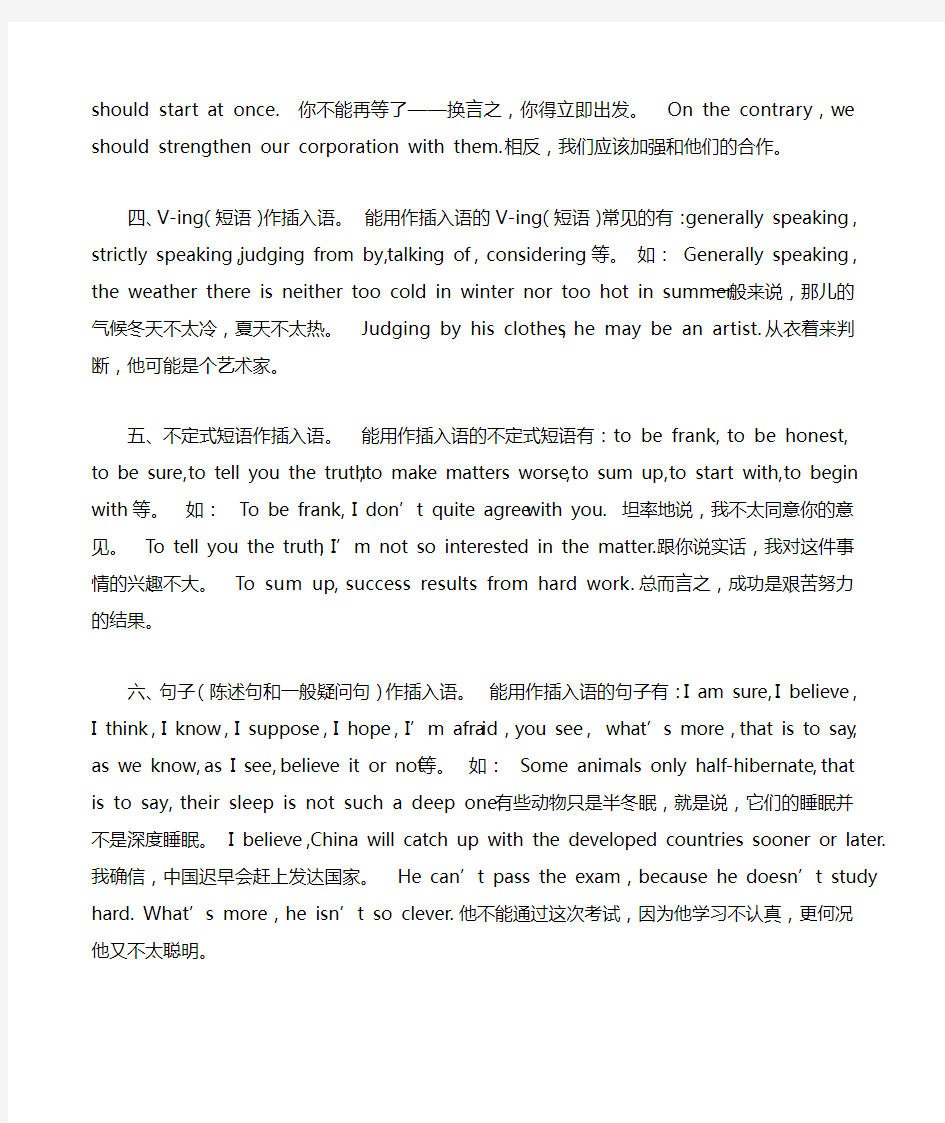英语插入语用法详解


英语中的插入语
插入语一般对一句话作一些附加的说明。它是中学英语语法的重点,也是高考的考点。通常与句中其它部分没有语法上的联系,将它删掉之后,句子结构仍然完整。插入语在句中有时是对一句话的一些附加解释、说明或总结;有时表达说话者的态度和看法;有时起强调的作用;有时是为了引起对方的注意;还可以起转移话题或说明事由的作用;也可以承上启下,使句子衔接得更紧密一些。掌握这一语言现象不仅有利于对英语句子等的理解,还有利于提高写作等的水平。插入语的类型较多,常见的如下几种:
一、形容词(短语)作插入语。能用作插入语的形容词(短语)常见的有:true,wonderful,excellent,strange to say,most important of all,sure enough等。如:True,it would be too bad.真的,太糟了。Wonderful,we have won again.太好了,我们又赢了。Strange to say,he hasn’t got my letter up to now.说来也奇怪,他到现在还没有收到我的信。Most important of all,we must learn all the skills.最重要的是,我们必须掌握所有的技巧。
二、副词(短语)作插入语。能用作插入语的副词(短语)有:indeed,surely,still,otherwise,certainly,however,generally,personally,honestly,fortunately,luckily,though,besides,exactly,perhaps,maybe,probably,frankly,or rather等。如:When he got to there,he found,however,that the weather was too bad.可是到了那儿之后他发现,那儿的天气太坏了。Otherwise,he would still be at home.不然的话,他还会在家的。
三、介词短语作插入语。能用作插入语的介词短语有:in fact,in one’s opinion,in general,in a word,in other words,in a few words,of course,by the way,as a result,for example,on the contrary,on the other hand,to one’s surprise,in short,as a matter of fact,in conclusion,in brief 等。如:You can’t wait anymore-in other words,you should start at once.你不能再等了——换言之,你得立即出发。On the contrary,we should strengthen our corporation with them.相反,我们应该加强和他们的合作。
四、V-ing(短语)作插入语。能用作插入语的V-ing(短语)常见的有:generally speaking,strictly speaking,judging from by,talking of,considering等。如:Generally speaking,the weather there is neither too cold in winter nor too hot in summer.一般来说,那儿的气候冬天不太冷,夏天不太热。Judging by his clothes,he may be an artist.从衣着来判断,他可能是个艺术家。
五、不定式短语作插入语。能用作插入语的不定式短语有:to be frank,to be honest,to be sure,to tell you the truth,to make matters worse,to sum up,to start with,to begin with等。如:To be frank,I don’t quite agree with you.坦率地说,我不太同意你的意见。To tell you the truth,I’m not so interested in the matter.跟你说实话,我对这件事情的兴趣不大。To sum up,success results from hard work.总而言之,成功是艰苦努力的结果。
六、句子(陈述句和一般疑问句)作插入语。能用作插入语的句子有:I am sure,I believe,I think,I know,I suppose,I hope,I’m afraid,you see,what’s more,that is to say,as we know,as I see,believe it or not等。如:Some animals only half-hibernate,that is to say,their sleep is not such a deep one.有些动物只是半冬眠,就是说,它们的睡眠并不是深度睡眠。I believe,China will catch up with the developed countries sooner or later.我确信,中国迟早会赶上发达国家。He can’t pass the exam,because he doesn’t study hard. What’s more,he isn’t so clever.他不能通过这次考试,因为他学习不认真,更何况他又不太聪明。
插入语的应用
插入语(句)是说话者对所表达意思的补充、强调、解释或者说话的态度,其位置灵活,常常用逗号或破折号与其他成分隔开,并且在语法上不影响其他成分。例如:
I think,she has no feeling for your trouble. / She,I think,has no feeling for your trouble. 我想,她对你的遭遇无动于衷。
一. 常见的插入语和插入句。
1. 插入语常以副词(副词短语)、形容词(形容词短语)、介词短语、非谓语动词短语等形式出现。
( 1 )常见的副词及短语:indeed,surely,however,obviously,frankly,naturally,luckily / happily for sb. certainly 等。
( 2 )常见的形容词及短语:funny,needless to say (不用说),most important of all 等。
( 3 )常见的介词短语:by the way,in a few words / in sum / in short (简而言之),in other words,in general,in one's opinion / judgment (按照某人的意见),in fact,in the first place,of course,to one's knowledge / surprise / regret /satisfaction / mind / joy / disappointment 等。
( 4 )常见的现在分词短语:strictly / generally / honestly / personally / exactly / physically / speaking (严格地/ 一般地/ 坦诚地等)说;judging from / by …(根据……判断)等。
( 5 )常见的动词不定式短语:to be sure (无疑地),to sum up (概括地说),to tell the truth,to be honest,to be short,to conclude,to put it briefly,to put it in another way,to begin (start )with 等。
注意:上述单词或短语作插入语和状语时的区别。例如:
( 1 )Frankly,he'd like to listen to music.
(副词作插入语,表示说话人的态度)
Here you should speak frankly.
(副词作状语)
( 2 )True,your daughter is at home now. (形容词作插入语)
He came back,hungry and tired. (形容词作状语)
( 3 )Judging from what he said,he does look down his elder brother. (现在分词作插入语,其主语不是句中的主语,只是说话者的附加说明)
Seeing from the window,he can see the lake. (现在分词作状语,逻辑主语是句中的主语he )
( 4 )To tell you the truth,he doesn't quite agree with this idea. (不定式作插入语,动作主体不是句中的主语,只是说话者的附加说明)To buy the machine,he went to Beijing. (不定式作目的状语,逻辑主语是句中的主语he )
2. 插入句为简短的、具有完整意义的句子。常见的插入句如下:I think / hope / guess / know / believe / suppose,I am sure (我可以肯定地说),that is (to say )(也就是说),it seems (看来是),as I see it (照我看来),what's more,what's worse,what is important / serious (重要/ 严重的是),I'm afraid (恐怕),it is said (据说),as we all know (众所周知)等。
插入句独立性强,一般用标点符号将其与其他句子成分隔开。应当特别注意疑问句的插入句,它一般为倒装语序且无任何标点符号,而且整个疑问句应当保持陈述语序。例如:
( 1 )What should I do first?
What do you think I should do first?(被插入的疑问句原来为倒装语序,插入后成为陈述语序)
( 2 )Who is singing?
Who do you think is singing?(被插入的疑问句原来就是陈述语序,不需要做调整)
